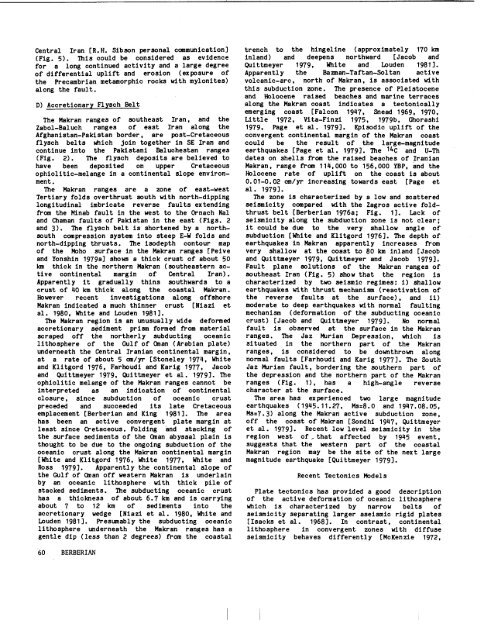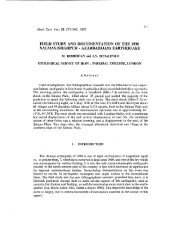PDF COPY - Manuel berberian
PDF COPY - Manuel berberian
PDF COPY - Manuel berberian
Create successful ePaper yourself
Turn your PDF publications into a flip-book with our unique Google optimized e-Paper software.
Central Iran [RoH. Slbson personal communication]<br />
(Fig. 5). This could be considered as evidence<br />
for a long continued activity and a large degree<br />
of differential upllft and erosion (exposure of<br />
the Precambrlan metamorphic rocks with mylonltes)<br />
along the fault.<br />
D) Accretlonary Flysch Belt<br />
The Mokran ranges of southeast Iran, and the<br />
Zabol-Baluch ranges of east Iran along the<br />
Afghanlstan-Paklstan border, are post-Cretaceous<br />
flysch belts which join together in SE Iran and<br />
continue into the Pakistani Baluchestan ranges<br />
(Fig. 2). The flysch deposits are believed<br />
have been deposited on upper Cretaceous<br />
ophlolltlc-melange in a continental slope environment.<br />
The Makran ranges are a zone of east-west<br />
Tertiary folds overthrust south with north-dlpplng<br />
longitudinal imbricate reverse faults extending<br />
from the Hinab fault in the west to the Ornach Nal<br />
and Chsman faults of Pakistan in the east (Figs.<br />
and 3). The flysch belt is shortened by a northsouth<br />
compression system into steep E-W folds and<br />
north-dipping thrusts. The isodepth contour map<br />
of the Moho surface in the Makran ranges [Pelve<br />
and Yonshln 1979a] shows a thick crust of about 50<br />
km thick in the northern Mokran (southeastern active<br />
continental margin of Central Iran).<br />
Apparently it gradually thins southwards to a<br />
crust of ~0 km thick along the coastal Mokran.<br />
However recent investigations along offshore<br />
Mokran indicated a much thinner crust [Niazi et<br />
al. 1980, White and Louden 1981].<br />
The Makran re,ion is an unusually wide deformed<br />
accretlonary s~dlment prism formed from material<br />
scraped off the northerly subductlng oceanic<br />
lithosphere of the Gulf of O~an (Arabian plate)<br />
underneath the Central Iranian continental margin,<br />
at a rate of about 5 cmlyr [Stoneley 197q, White<br />
and Klltgord 1976, Farhoudi and Katie 1977, Jacob<br />
and Quittmeyer 1979, Oulttmeyer et al. 1979]. The<br />
ophiolltlc melange of the Makran ranges cannot be<br />
interpreted as an indication of continental<br />
closure, since subduction of oceanic crust<br />
preceded and succeeded its late Cretaceous<br />
emplacement [Berberian and King 1981]. The area<br />
has been an active convergent plate margin at<br />
least since Cretaceous. Folding and stacking of<br />
the surface sediments of the Oman abyssal plain is<br />
thought to be due to the ongoing subductlon of the<br />
oceanic crust along the Makrsn continental margin<br />
[White and Klltgord 1976, White 1977, White and<br />
Ross 1979]. Apparently the continental slope of<br />
the Gulf of O~an off western Makran is underlain<br />
by an oceanic lithosphere with thick pile of<br />
stacked sediments. The subducting oceanic crust<br />
has a thickness of about 6.7 km and is carrying<br />
about 7 to 12 km of sediments into the<br />
sceretionary wedge [Niazl etal. 1980, White and<br />
Louden 1981]. Presumably the subductlng oceanic<br />
lithosphere underneath the Makran ranges has a<br />
gentle dip (less than 2 degrees) from the coastal<br />
trench to the hingeline (approximately 170 km<br />
inland) and deepens northward [Jacob and<br />
Oulttmeyer 1979, White and Louden 1981].<br />
Apparently the Bazman-Taftan-~oltan active<br />
volcanic-arc, north of Makran, is associated with<br />
this subduction zone. The presence of Pleistocene<br />
and Molocene raised beaches and marine terraces<br />
along the Makran coast indicates a tectonically<br />
emerging coast [Falcon 19~7, Sneed 1969, 1970,<br />
Little 1972, Vita=Finzl 1975, 1979b, Ghorashl<br />
1979, Page etal. 1979]. Episodic uplift of the<br />
convergent continental margin of the Makran coast<br />
could be the result of the large-magnitude<br />
earthquakes [Page etal. 1979]. The I&C and U-Th<br />
dates on shells from the raised beaches of Iranlan<br />
Makran, range from 11~,000 to 156,000 YBP, and the<br />
Holocene rate of uplift on the coast is about<br />
0.01-0,02 cm/yr increasing towards east [Page et<br />
al. 1979].<br />
The zone is characterized by a low and scattered<br />
selsmlctty compared with the Zagros actlve foldthrust<br />
belt [Berberian 1976a; Fig. 1]. Lack of<br />
selsmlclty along the subductlon zone is not clear;<br />
it could be due to the very shallow angle of<br />
subductlon [White and Klltgord 1976]. The depth of<br />
earthquakes in Makran apparently increases from<br />
very shallow at the coast to 80 km inland [Jacob<br />
and Quittmeyer 1979, Quittmeyer and Jacob 1979].<br />
Fault plane solutions of the Mokran ranges of<br />
southeast Iran (Fig. 5) show that the region<br />
characterized by two seismic regimes: i) shallow<br />
earthquakes with thrust mechanism (reactivation of<br />
the reverse faults at the surface), and ii)<br />
moderate to deep earthquakes with normal faulting<br />
mechanism (deformation of the subduetlng oceanic<br />
crust) [Jacob and Oulttmeyer 1979]. No normal<br />
fault is observed at the surface in the Makran<br />
ranges. The Jaz Murlan Depression, which is<br />
situated in the northern part of the Makran<br />
ranges, is considered to be downthrown along<br />
normal faults [Farhoudl and Karlg 1977]. The South<br />
Jaz Murian fault, bordering the southern part of<br />
the depression and the northern part of the Makran<br />
ranges (Fig. I), has a high-angle reverse<br />
character at the surface.<br />
The area has experienced two large magnitude<br />
earthquakes (1945.11.27, Ms=8.0 and 19~7.08.05,<br />
Ms=7.3) along the Mokran active subduction zone,<br />
off the coast of Makran [~ondhl 1947, Oulttmeyer<br />
etal. 1979]. Recent low level seismicity in the<br />
region west of ~ that affected by 1945 event,<br />
suggests that the western part of the coastal<br />
Makran region may be the site of the next large<br />
magnitude earthquake [Ouittmeyer 1979].<br />
Recent Tectonics Models<br />
Plate tectonics has provided a good description<br />
of the active deformation of oceanic lithosphere<br />
which is characterized by narrow belts of<br />
selsmicity separating larger aselsmic rigid plates<br />
[Isacks et al. 1968]. In contrast, continental<br />
lithosphere in convergent zones with diffuse<br />
selsmlclty behaves differently [McKenzle 1972,<br />
60 BERBERIAN







